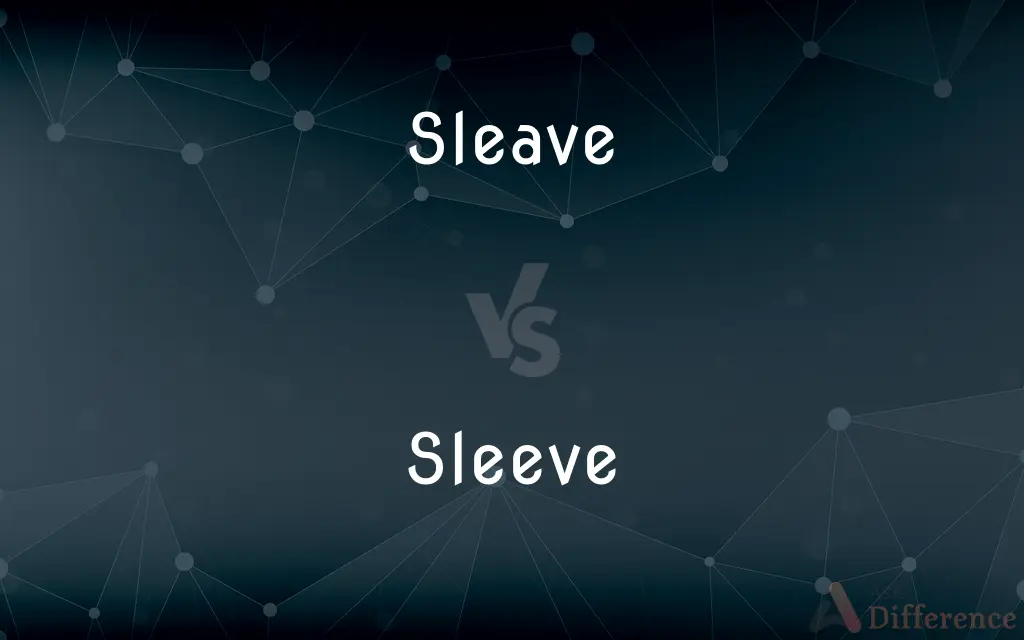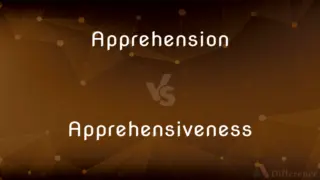Sleave vs. Sleeve — What's the Difference?
By Tayyaba Rehman — Updated on October 3, 2023
Sleave refers to a type of thin, untwisted silk thread, while sleeve is the part of a garment that covers the arm.

Difference Between Sleave and Sleeve
Table of Contents
ADVERTISEMENT
Key Differences
Sleave and sleeve, though phonetically similar, refer to different things. Sleave is a specific type of thread, often used historically in textile manufacturing. Made from silk, sleave has an untwisted texture and was pivotal in various crafts. On the other hand, sleeve refers to a garment's part that covers the arm. Ranging from short, long, puffed, to bell-shaped, the sleeve is a defining feature of many clothing items. In the realm of textiles, the difference between sleave and sleeve becomes clear. While sleave would be involved in the creation and decoration of fabrics, sleeve would be one of the resulting features of a finished garment. The usage and relevance of these terms vary widely; sleave might be more familiar to those in textile and craft circles, while sleeve is a ubiquitous term known widely due to its association with everyday clothing.
Comparison Chart
Definition
A type of thin, untwisted silk thread.
Part of a garment that covers the arm.
Material
Made from silk.
Made from various fabrics depending on the garment.
Usage
In textile manufacturing and crafts.
In fashion and everyday clothing.
Common Context
Weaving, embroidery.
Clothing design, fashion.
ADVERTISEMENT
Related Terms
Thread, silk, untwisted.
Cuff, armhole, style.
Compare with Definitions
Sleave
Sleave is primarily derived from silk.
Only genuine sleave comes from silk, not synthetic materials.
Sleeve
Sleeves can vary in length and style.
The shirt's short sleeves were perfect for summer.
Sleave
Sleave has a specific texture distinct from other threads.
The untwisted nature of sleave gives it a unique appearance.
Sleeve
A sleeve can also refer to a protective cover.
She slid the record into its sleeve.
Sleave
Sleave is an untwisted silk thread.
The delicate embroidery was done with fine sleave.
Sleeve
"Sleeve" can metaphorically indicate one's emotions or thoughts.
He wears his heart on his sleeve.
Sleave
Sleave was pivotal in certain crafting techniques.
Traditional weavers often preferred sleave for specific patterns.
Sleeve
Sleeve designs can be a fashion statement.
Puffed sleeves are back in fashion this season.
Sleave
Sleave was used historically in textile crafts.
Many vintage garments boast intricate designs made with sleave.
Sleeve
A sleeve (O. Eng. slieve, or slyf, a word allied to slip, cf.
Sleave
A fine thread or skein of thread.
Sleeve
A part of a garment that covers all or part of an arm.
Sleave
(weaving) To separate, as threads; to divide, as a collection of threads.
Sleeve
A case into which an object or device fits
A record sleeve.
Sleave
The knotted or entangled part of silk or thread.
Sleeve
A tattoo that covers all or a large part of the arm.
Sleave
Silk not yet twisted; floss.
Sleeve
To furnish or fit with sleeves or a sleeve.
Sleave
The knotted or entangled part of silk or thread.
Sleep that knits up the ravell'd sleave of care.
Sleeve
The part of a garment that covers the arm.
The sleeves on my coat are too long.
Sleave
To separate, as threads; to divide, as a collection of threads; to sley; - a weaver's term.
Sleeve
A (usually tubular) covering or lining to protect a piece of machinery etc.
This bearing requires a sleeve so the shaft will fit snugly.
Sleeve
A protective jacket or case, especially for a record, containing art and information about the contents; also the analogous leaflet found in a packaged CD.
Sleeve
A tattoo covering the whole arm.
Sleeve
A narrow channel of water.
Sleeve
Sleave; untwisted thread.
Sleeve
(British Columbia) A serving of beer smaller than a pint, typically measuring between 12 and 16 ounces.
Sleeve
(US) A long, cylindrical plastic bag of cookies or crackers.
Sleeve
(electrical engineering) A double tube of copper into which the ends of bare wires are pushed so that when the tube is twisted an electrical connection is made. The joint thus made is called a McIntire joint.
Sleeve
(transitive) To fit and attach a sleeve to an upper garment (e.g. to a shirt, blouse, sweater, jacket, coat, etc.) or to a folder.
Sleeve
(magic tricks) To hide something up one's sleeve.
Sleeve
See Sleave, untwisted thread.
Sleeve
The part of a garment which covers the arm; as, the sleeve of a coat or a gown.
Sleeve
A narrow channel of water.
The Celtic Sea, called oftentimes the Sleeve.
Sleeve
A tubular part made to cover, sustain, or steady another part, or to form a connection between two parts.
Sleeve
A double tube of copper, in section like the figure 8, into which the ends of bare wires are pushed so that when the tube is twisted an electrical connection is made. The joint thus made is called a McIntire joint.
Sleeve
To furnish with sleeves; to put sleeves into; as, to sleeve a coat.
Sleeve
The part of a garment that is attached at armhole and provides a cloth covering for the arm
Sleeve
Small case into which an object fits
Sleeve
A sleeve is a part of a garment covering the arm.
Her dress had long, flowing sleeves.
Common Curiosities
How does sleave differ from other types of thread?
Sleave is distinct due to its untwisted texture and silk origin.
Are sleave and sleeve related in any way?
No, sleave refers to a type of thread, while sleeve refers to a part of clothing.
What is sleave in the context of textiles?
Sleave is a type of thin, untwisted silk thread.
Can sleave be made from materials other than silk?
Authentic sleave is made from silk, but there might be imitation threads made from other materials.
Do all garments have sleeves?
No, some garments like tube tops or halters lack sleeves.
Is the phrase "wear one's heart on one's sleeve" literal?
No, it's a metaphorical expression meaning to openly display one's emotions.
What is the primary purpose of a sleeve in fashion?
A sleeve is designed to cover the arm in various lengths and styles.
Is sleave still popularly used today?
While not as common as in the past, sleave is still used in specific crafts and textile techniques.
Are there different types of sleave?
While sleave primarily refers to untwisted silk thread, its quality or fineness might vary.
Can the term "sleeve" be used outside of fashion?
Yes, "sleeve" can refer to protective covers or casings, like a record sleeve.
Can a sleeve be detachable?
Yes, some clothing designs feature detachable sleeves for versatility.
Is the quality of sleave consistent across all uses?
The quality of sleave can vary based on its intended use, sourcing, and manufacturing.
How can one differentiate between sleave and sleeve in conversation?
Context is crucial; if discussing textiles or threads, "sleave" is likely, while in fashion or clothing contexts, "sleeve" is probable.
Are sleave and sleeve interchangeable in any context?
No, they have distinct meanings and are not interchangeable.
Can you name some popular sleeve styles?
Yes, there are many, such as bell sleeves, puff sleeves, and batwing sleeves.
Share Your Discovery

Previous Comparison
Lapsarian vs. Prelapsarian
Next Comparison
Apprehension vs. ApprehensivenessAuthor Spotlight
Written by
Tayyaba RehmanTayyaba Rehman is a distinguished writer, currently serving as a primary contributor to askdifference.com. As a researcher in semantics and etymology, Tayyaba's passion for the complexity of languages and their distinctions has found a perfect home on the platform. Tayyaba delves into the intricacies of language, distinguishing between commonly confused words and phrases, thereby providing clarity for readers worldwide.














































